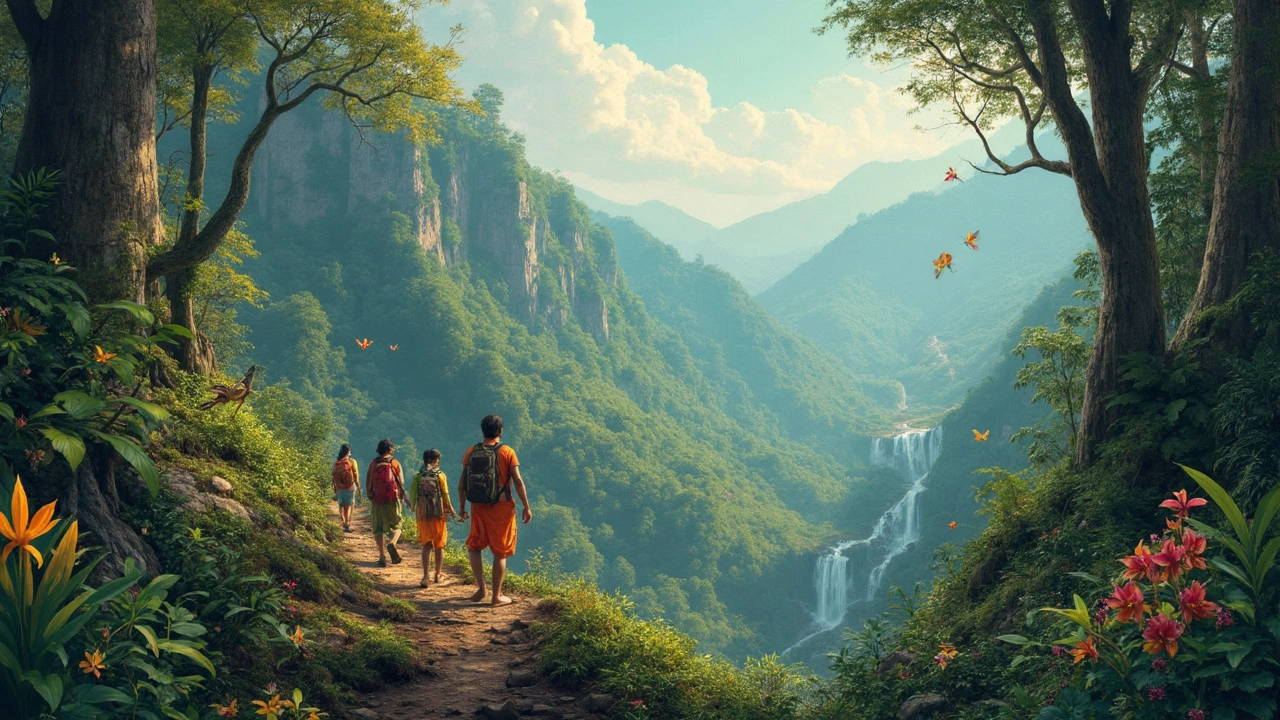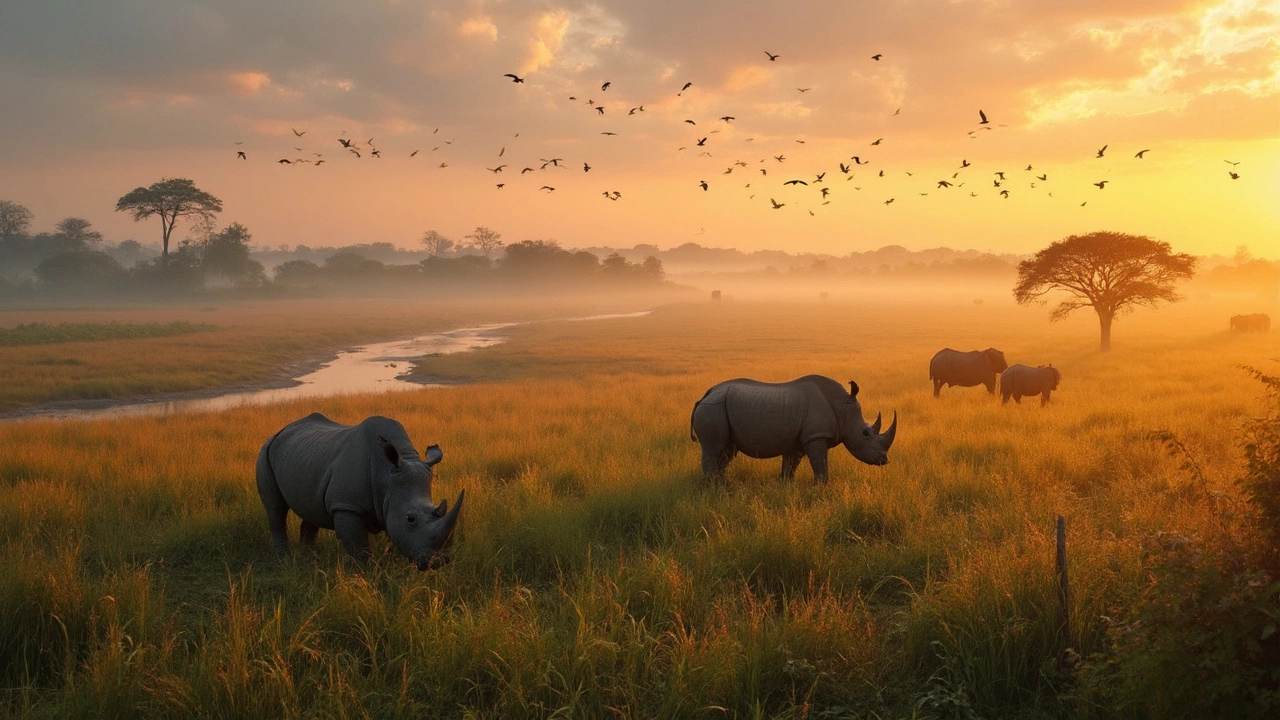Ever heard someone say India is more than a land of temples and palaces? It's true, and honestly, the country's natural wonders sometimes don’t get nearly enough hype. India isn’t just about spicy food and crowded markets. It’s also home to seven jaw-dropping UNESCO Natural Heritage Sites that put it on the global travel map for all the right reasons. Imagine places where one-horned rhinos roam free, living root bridges swing over emerald streams, ancient caves echo with bats, and the air carries stories older than time. These protected sites hold secrets even most Indians haven’t heard about. Before you write off India as just another destination, you’ll want to see what wild treasures are waiting to surprise you.
Kaziranga National Park: Rhinos, Swamps, and Living Legends
They say you haven’t truly seen India’s wild side until you’ve been to Kaziranga National Park. Tucked away in Assam, this park is a powerhouse— stretching over 430 square kilometers and featuring an eerie expanse of tall elephant grass, dense forests, swamps, and sandy river islands crisscrossed by the Brahmaputra. The real celebs around here? The Indian one-horned rhinoceros. Nearly two-thirds of the world’s remaining population live within these park boundaries. On a foggy morning safari, the sight of rhinos lumbering through the grass—sometimes just a few meters away— is one you’ll never forget. In fact, Kaziranga has bounced back from the brink: poaching decimated rhino numbers in the 1900s, but strong conservation led to a whopping recovery. A 2022 census reported over 2,600 rhinos, an inspiring sign of what focused protection can do. But Kaziranga isn’t just about rhinos. It’s also teeming with tigers (yep, the highest density of tigers in any protected area in the world), wild water buffalo, elephants, and even the endangered swamp deer. Bird lovers, you’re spoiled here—over 490 bird species have been spotted, turning the wetlands into living rainbows during winter migrations. If you ever go, here’s a pro-tip: choose an early morning or late afternoon safari for the best wildlife action, and don’t forget binoculars for birdwatching. Luckily, local lodges cater to every budget, from backpackers to luxury seekers. Kaziranga’s place on the list of India’s natural heritage isn’t just about numbers; it’s proof that people can actually turn the tide for the wild.
Great Himalayan National Park: Peak Wilderness, Epic Biodiversity
If you dream of untouched landscapes dotted with snow leopards, rare wildflowers, and hidden villages where the mountain culture feels unchanged in centuries, head to Himachal Pradesh’s Great Himalayan National Park (GHNP). It sprawls across over 900 sq km at the meeting point of the subtropical and alpine, making it a playground for scientists, trekkers, and folks wanting to lose their phones and find themselves. GHNP made the UNESCO list in 2014, pretty late compared to others, mostly because its untamed wilderness remained off-the-grid for decades. Climbing its rocky passes, you’ll come across some of India’s rarest animals: elusive snow leopards, Himalayan brown bears, musk deer, and over 375 types of birds. But it’s the Bakriwala herders—shepherding flocks up the mountains like they’ve done for centuries—who give the landscape its soul. Visit between April and June when the valleys erupt in carpets of wild rhododendrons, primulas, and blue poppies. Serious trekkers can tackle the multi-day hikes through the Tirthan, Sainj, and Jiwa Nal valleys, often pitching tents beside glacier-fed streams. GHNP is also a living laboratory, studied for its endemic species. Scientists clocked over 832 plant species, 31 mammals, 209 birds, and a host of reptiles and amphibians. If you crave something more than just sightseeing, this is your haven—GHNP allows immersive eco-tourism, but strictly regulates numbers to keep its wilderness, well, wild. I went there with Neha last year, and we didn’t hear a car for three days straight. Absolute bliss. A heads-up though: there’s no touristy hustle here—basic guesthouses, minimal phone signal, and the kind of quiet you can almost taste.

Sundarbans National Park: The Tidal Tiger Land
If you’re fascinated by strange, mysterious landscapes, the Sundarbans are a must. Imagine a labyrinth of mudflats and mangroves where rivers meet the Bay of Bengal, tigers swim between islands, and saltwater crocs lurk in shadowy creeks. Spread over 10,000 sq km (of which about half is in India, the rest in Bangladesh), this region is the world’s largest mangrove forest and one of the wildest places left on Earth. The site was added to the UNESCO World Heritage list in 1987, mostly because it houses more than 250 tigers that have become famous for their swimming skills. Tiger spotting here is a lottery—most people see just tiger pawprints. But if you get lucky, it’s a next-level wildlife experience. Even if the tigers play hard to get, the birdlife never disappoints: kingfishers, herons, storks, and eagles. The mangroves themselves are ingenious—growing in brackish, shifting land where few other plants could survive, they’re the green guardians keeping the coasts from vanishing into the sea. The local honey collectors (called "mauli") face a real-life survival test every year, dodging tigers as they venture deep into the forest. River cruises are the most popular way in (start at Godkhali or Sajnekhali), and you’ll want to pack serious mosquito repellent and sunblock. If you get itchy feet for adventure, you’ll feel the Sundarbans’ pull. As climate change worsens, places like the Sundarbans remind us that the fight for nature is far from over.
Natural Heritage of India is unique not just for these places, but for the stories they hold—of wildlife revivals, ancient tribes, and landscapes defying the odds. If you dig stats, check out the table below that compares some key facts across these seven UNESCO sites.
| Site | State/Location | UNESCO Year | Main Attraction | Key Wildlife |
|---|---|---|---|---|
| Kaziranga National Park | Assam | 1985 | One-horned rhinos | Rhinos, tigers, elephants |
| Great Himalayan National Park | Himachal Pradesh | 2014 | Snow leopards, trekking | Snow leopards, brown bears |
| Sundarbans National Park | West Bengal | 1987 | Mangrove forests, tigers | Tigers, crocodiles |
| Nanda Devi and Valley of Flowers National Parks | Uttarakhand | 1988, 2005 | Himalayan peaks, wildflower meadows | Snow leopards, musk deer, blue sheep |
| Manas Wildlife Sanctuary | Assam | 1985 | Wild water buffalo, lush forests | Rhinos, elephants, tigers |
| Keoladeo National Park | Rajasthan | 1985 | Waterbirds, wetland ecosystem | Cranes, pelicans, ducks |
| Western Ghats | Karnataka, Kerala, Tamil Nadu, Maharashtra | 2012 | Biodiversity hotspot, rainforests | Lions-tailed macaque, Nilgiri tahr, tigers |
From Manas to the Western Ghats: Wild Treasures You Can’t Ignore
Travel west from Assam and you’ll hit Manas Wildlife Sanctuary, another gem nestling along the Himalayan foothills. What separates Manas from other parks is its surreal mix: a magical blend of grassland and forest where elephants, golden langurs, and pygmy hogs are part of the daily traffic. A huge reason Manas stands out is its biodiversity—home to 55 mammal species, 50 reptiles, and 380 kinds of birds. People say the wild water buffaloes here look like they’ve rolled in motor oil, their horns almost comically wide. Birdwatchers, you’re in heaven too: rare Bengal floricans, gigantic hornbills, and eagles dot the wetlands. Safari by jeep is classic, but a bumpy ride in a traditional wooden boat on the Manas River feels next-level. Manas was once listed as "World Heritage in Danger" because of poaching and unrest, but it’s bounced back with stronger protection and local community support. Assam’s parks often play second fiddle to those in Madhya Pradesh or Rajasthan, but honestly, they deserve center stage.
Now, let’s jump to Rajasthan for a totally different vibe at Keoladeo National Park, aka Bharatpur Bird Sanctuary. If you thought deserts had zero wildlife, think again. This 29 sq km park transforms into a watery paradise every winter, drawing over 350 bird species—including the Siberian crane, which flies nearly 4,000 kilometers from arctic Russia. A cycle rickshaw ride here is mandatory; guides double as birdwatchers with eagle eyes. The park’s creation is a bit of a “man-made miracle”—Maharaja Suraj Mal flooded the area over a century ago to attract ducks for royal shoots. Today, it’s a magnet for birders, nature photographers, and anyone needing a break from Rajasthan’s stone forts and heat. Tips: pack a pair of good binoculars (leave the phone zoom at home), visit between November and March, and don’t miss the sunrise walks when the marsh comes alive.
Western Ghats, running parallel to India’s west coast, tie the heritage list together. Covering 160,000 sq km across six states, few realize it’s among the top eight "hottest hotspots" of biological diversity in the world, richer in species than entire continents. The region is peppered with hill stations, spice plantations, and stretches of untouched rainforest that feel like time capsules. Some trees, like the sacred fig, are over 800 years old, and hundreds of endemic plants aren’t found anywhere else. Wildlife? You’ve got it: elusive lion-tailed macaques, Nilgiri tahr, Malabar giant squirrels, and king cobras, to name a few. The Ghats also influence India’s monsoon system, making them essential for all life in southern India. Trekkers swear by the misty slopes of the Nilgiris, coffee lovers can’t get enough of Coorg’s plantations, and history buffs geek out over ancient fort ruins hidden in the undergrowth. The best travel hack? Hire a local nature guide—they know where all the rare orchids bloom and can point out creatures hiding in plain sight.

Nanda Devi, Valley of Flowers: Himalayan Dreams Unfold
Let’s not forget the jewel of Uttarakhand: Nanda Devi and Valley of Flowers National Parks. These twin parks are sandwiched between sky-tickling Himalayan peaks and have that magical, fairy-tale vibe you only read about in novels. The Valley of Flowers, famous for its monsoon bloom, bursts into a psychedelic display of blue poppies, cobra lilies, and Himalayan daisies, drawing botanists and trekkers every July to September. The area’s legends run deep—locals believe gods and goddesses bless the flowers, and somehow, standing on a misty ridge smelling the wild thyme, you almost believe it. Climbing nearby Nanda Devi, India’s second-highest peak (7,816 meters), is strictly regulated but adds to the region’s allure. The park is a haven for snow leopards, bharals (blue sheep), and the elusive Himalayan musk deer. There’s no direct road—getting here is old-school: buses, jeeps, long forest hikes. Your reward? Cozy village homestays, views straight out of a fantasy film, and wild mountain rivers that’ll have you reaching for your camera all day. Birders spot rare Himalayan monals, and the lucky catch a glimpse of a red fox darting past. Valley of Flowers gets around 12,000 visitors each year, and only during the short summer window, which keeps the park pristine. If you’re the type who likes the bragging rights of going “where few have gone,” put this high on your bucket list.
These seven UNESCO World Heritage Sites show off India’s real wild side, a reminder that travel is way more than just history and food. They’re places where tigers prowl, birds migrate thousands of miles, flowers bloom in impossible places, and cultures have learned to live side-by-side with nature for centuries. They teach you patience (wildlife sightings aren’t handed out like Starbucks lattes), wonder, and above all, humility. Next time you’re planning a trip around India, ditch the obvious choices. Go where the land still holds its secrets—and maybe, get a little mud on your boots along the way.
